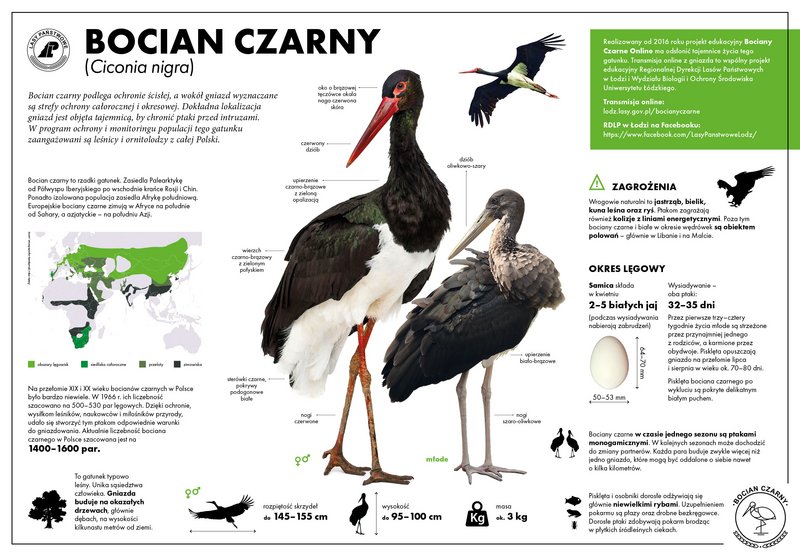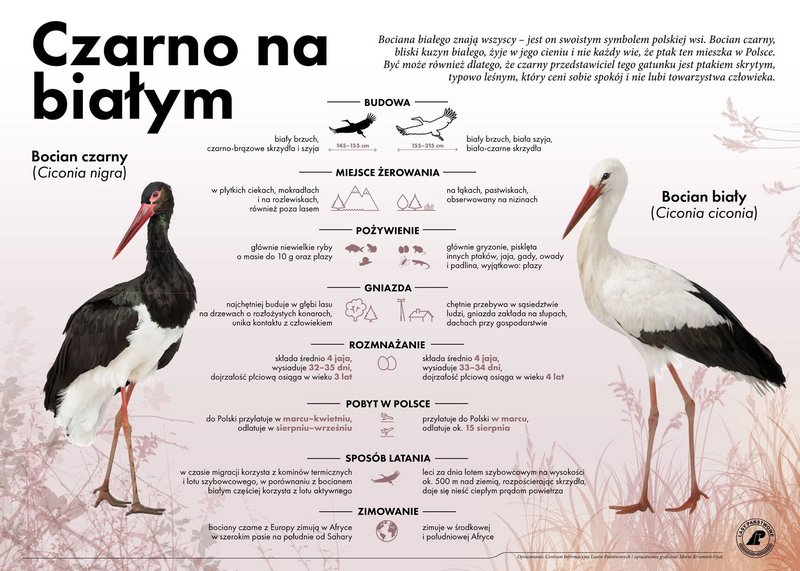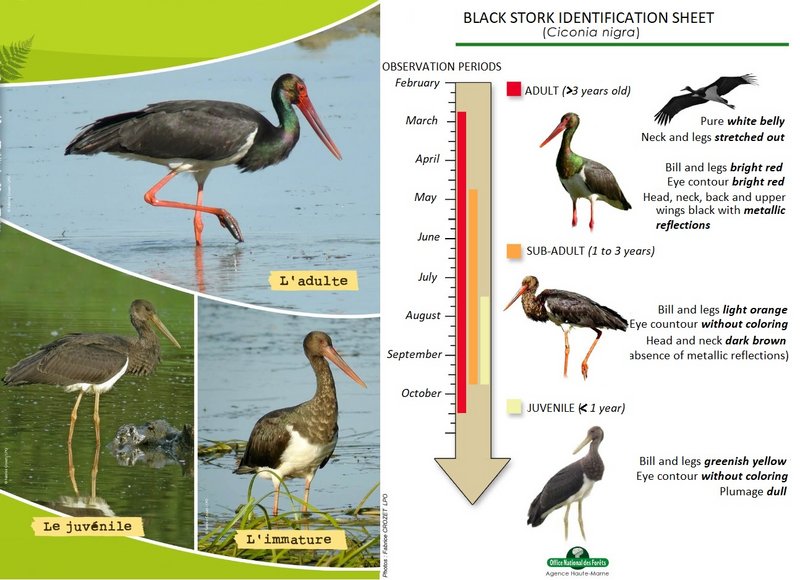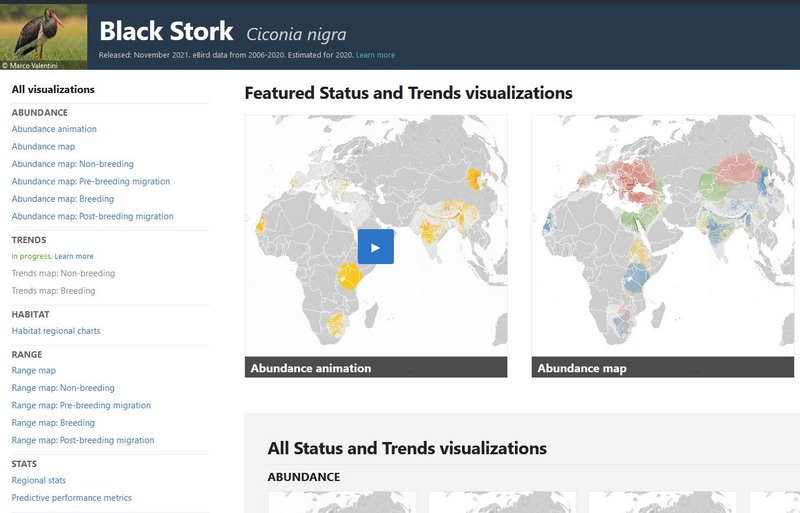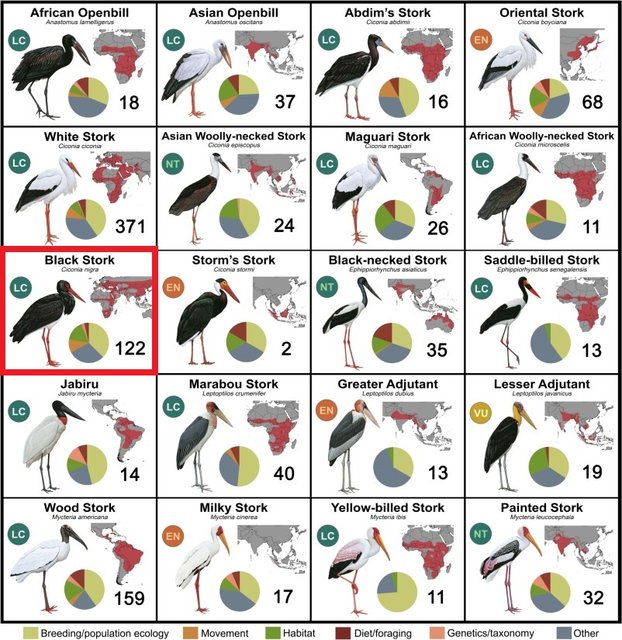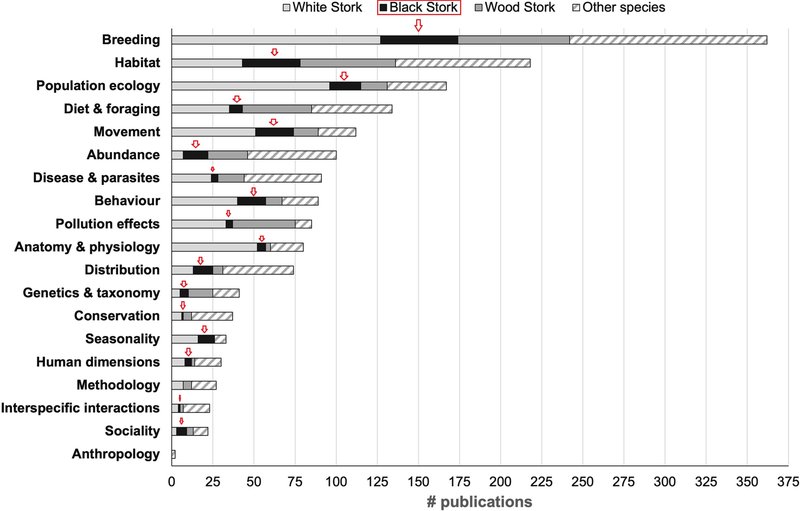Age determination
1st calendar year (juvenile stork)
Fledged young storks
Brutplatz in Mecklenburg-Vorpommern. Die Jungstörche sind erst am 15./16.08.2009 ausgeflogen. Die Brut fand sehr spät am 07.05.09 statt. Beachte - durch die Schattenzonen ähnelt der Gefiederfarbton eher einem älteren Storch und wird daher verfälscht. Die Brauntöne kommen hier nicht zur Geltung. Das Brutmännchen war im 3. KJ und hat sich frisch verpaart, ein Grund für die späte Brut - Aufnahme vom 19.08.2009 - © C. Rohde -
pic:
https://schwarzstorchberingung.de/attac ... /BS203.JPG
Young stork
Classic young stork in the 1st year. Note the warm brown basic color (medium type) as well as the color of the beak and legs. The brown coloring, especially of the head, neck and chest area, can vary from a very dark to a very light brown tone. As early as the start of the 2nd calendar year in January/February, the first reddish tones appear on the beak, eye spot and legs. Photo taken on September 28th, 2009, Beit Shean Valley, Israel - © C. Rohde -
pic:
https://schwarzstorchberingung.de/attac ... /BS204.jpg
Flying young stork
A rather dark coloring type regardless of the lighting conditions. Photo taken on October 4th, 2009, Beit Shean Valley, Israel - © C. Rohde -
pic:
https://schwarzstorchberingung.de/attac ... /BS206.JPG
2nd calendar year (subadult)
Classic black stork in the 2nd year. - While the hand and arm covert markings in particular already tend towards adult storks (≥ 3rd year), the young stork markings can still be seen very clearly on the neck and head area. Note: head, throat and upper neck area with typical brown coloring for K2, also brownish edges (clouds) on the lower neck towards the chest, slightly pronounced eye spot with very pale red coloring, ditto beak, iris coloring. The faint red leg coloring is not a reliable indication for determining age. Birds in the 3rd and 4th year show similar coloring! Conclusion: always pay attention to the head and neck markings as well as the facial markings on birds from the 2nd year onwards! Photo taken on October 4th, 2009, Beit Shean Valley, Israel - © C. Rohde -
pic:
https://schwarzstorchberingung.de/attac ... /BS210.JPG
2nd calendar year (flight photo)
Black stork in the 2nd year - Note (independently of the head and neck markings mentioned above) the clearly brownish influence of the still young arm and hand coverts. Photo taken on October 1st, 2009, Jordan Valley, Israel - © C. Rohde -
pic:
https://schwarzstorchberingung.de/attac ... /BS211.JPG
3rd calendar year (subadult)
The picture on the left shows a black stork in its 3rd year. Its age was also confirmed by its ringing (Hungary "50WM"). The optimal lighting allows you to clearly see the remaining brownish scales on the neck. Apart from the facial markings (around the eyes), the bird is hardly distinguishable from a real adult stork (>3rd year). Behind the young stork on the right you can see another hidden black stork in its 3rd year (see the distinctive neck scales). When sampling larger groups of black storks in Israel, it was not possible to count them up to and including the 3rd year due to time constraints. They were treated like adult storks - only the exact sampling of birds in their 1st, 2nd and ≥ 3rd year was carried out. The results are still being evaluated and can be found later under "Migratory routes, resting". Photo taken on September 28th, 2009, Beit Shean Valley, Israel - © C. Rohde -
pic:
https://schwarzstorchberingung.de/attac ... e/neu9.JPG
Moulting cycle
With this breeding stork (male), you can take a good look at the large feathers. There is now several pieces of evidence (particularly by reading the color ring) that the "black ladies" can successfully raise offspring in the 3rd calendar year. Without going into detail about the large feather moulting cycle - in the photo you can see feathers from the first generation, particularly in the arm coverts, as well as feathers in the area of the primaries and secondaries (1st/2nd and sometimes 3rd generation). Incidentally, black storks have 21 primaries (20 visible) and white storks have 22. The outer primaries are always moulted last (descending from H1). In the wing of the black stork, H6-H9 are usually the longest. What was particularly striking (not visible in the photo) was the moulting state of the tail feathers. However, there are always complicated cases when it comes to distinguishing between the 3rd and 4th calendar year. Sometimes the feathers are bleached and often look like they are from the 1st generation! In the case of the male here, the markings on the head, neck and small arm coverts (fine details) were also decisive for the 3rd calendar year. Photo taken on 21.07.2009 - © C. Rohde
pic:
https://schwarzstorchberingung.de/attac ... ult3cy.jpg
source: Schwarzstorchschutz Deutschland Beringungsprojekt - Carsten Rohde https://schwarzstorchberingung.de/page2.php
